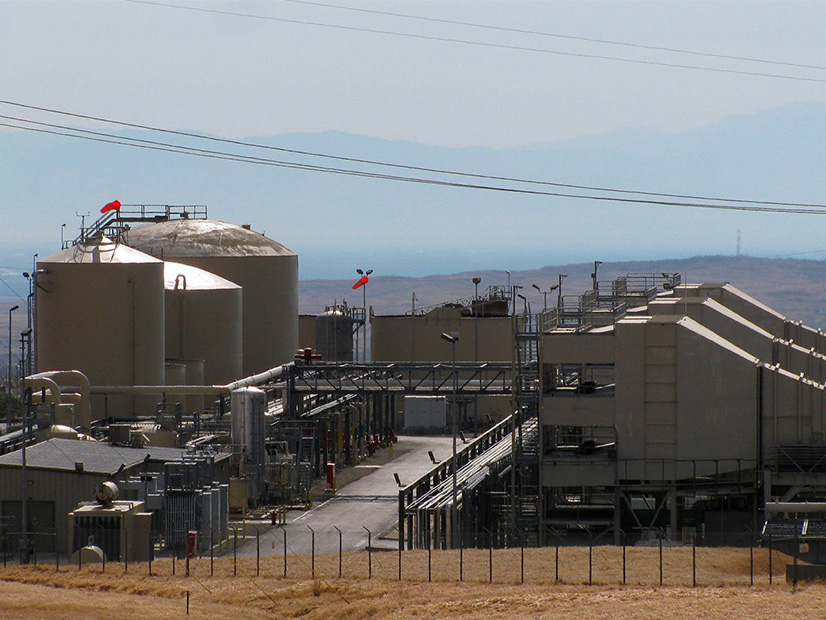CAISO applied to the U.S. Department of Energy this week for an emergency order meant to boost natural gas generation for grid reliability while potentially exceeding limits on harmful pollutants.
The request covers six generators including aging power plants and new mobile units at existing facilities that the ISO is hoping to connect by Sept. 17, providing a total of 200 MW of additional supply.
“The CAISO respectfully requests that [Secretary of Energy Jennifer Granholm] issue the requested emergency order by Sept. 10, 2021, or a soon as possible thereafter, authorizing specific electric generating resources located within California to test and operate at their maximum generation output levels when directed to do so by the CAISO, notwithstanding air quality or other permit limitations,” CAISO COO Mark Rothleder wrote to Granholm.
CAISO’s cited reasons include high temperatures in the West, wildfires that threaten the bulk power system, and “drought conditions [that] are greatly affecting the availability of hydroelectric power.”
“Given these circumstances, state officials have identified a need to secure additional generating capacity to meet expected electricity demand and reserve requirements,” Rothleder wrote.
“Despite efforts undertaken by load serving entities and the CAISO to secure additional generating capacity, the CAISO continues to forecast potential supply deficiencies,” he said. “For September, the CAISO continues to forecast a significant supply deficiency to meet planning reserve requirements during evening hours.
“Granting this request for an emergency order and authorizing the operation of additional generating capacity identified in this request when conditions merit is critical to the CAISO maintaining reliability and meeting its load obligations,” he wrote.
Use Only in a Level 2 Emergency
Two of the covered resources — Greenleaf Unit 1 in Sutter County and Roseville Energy Park in Placer County — are working with the state to deploy new generating capacity by mid-September, a crucial time in California when temperatures can rise while hydroelectric generation dwindles. The 30-MW mobile units are part of the California Department of Water Resources’ efforts to add generating capacity.
“These covered resources will not have completed federal environmental permitting requirements by this date and will not operate unless they are subject to a DOE emergency order,” CAISO said.
The mobile units “are not equipped with best available control technology to control emissions and have not completed permitting processes to obtain their operating permit under Title V of the Clean Air Act,” the ISO said.
Four older units that could be covered by a DOE order are the Midway Sunset Cogeneration Facility Unit in Kern County, the Alamitos Energy Center in Long Beach, the Huntington Beach Energy Project in Orange County, and the Walnut Creek Energy Park in the city of Industry, near Los Angeles.
CAISO “understands that the electric generating units identified in this request have derated their facilities based on conditions set forth in their permits regarding nitrogen oxide emissions, heat output as well as fuel throughput,” the request said. “Accordingly, the CAISO anticipates that the emergency order it is requesting may result in exceedance of National Ambient Air Quality Standards under the Clean Air Act.”
The ISO said it intends to dispatch the units “at levels that exceed their permitted values” as on-call resources in its day-ahead timeframe if it issues a grid alert and will direct the units to operate only if it enters a Level 2 Energy Emergency Alert — “i.e. after the CAISO has initiated the dispatch of reliability demand response resources.”
“In this case, these resources would operate outside of permitted levels only as needed to help mitigate the risks of a system emergency and avoid the need for the CAISO to curtail native load,” Rothleder wrote. “In addition, the CAISO requests authority to dispatch the covered resources during transmission emergencies to reduce or eliminate the need to curtail native load to protect against the next contingency on the electric system.”
The Alamitos and Huntington Beach plants are two of the four once-through cooling plants that the state decided to keep open for reliability despite their harm to sea life. (See OTC Plants to Remain Open, Calif. Water Board Rules.)
Other Efforts
In April, FERC conditionally approved the Midway Sunset plant as the state’s first systemwide reliability-must-run resource. The 248-MW plant, built in an oil field in the 1980s, was scheduled to retire this year. (See CAISO’s 1st System RMR Agreement Set for Hearing.)
CAISO, the California Energy Commission and the California Public Utilities Commission have been working to obey Gov. Gavin Newsom’s July 30 emergency proclamation by connecting resources that can meet projected energy shortfalls this year and next. (Calif. Governor Proclaims Emergency as Blackouts Loom.)
In June, the CPUC ordered load-serving entities to deploy 11.5 GW of new resources to come online from 2023 to 2026, and, in July, CAISO took the rare step of using its capacity procurement mechanism to procure additional generating capacity. (CAISO Issues Urgent Call for More Summer Capacity.)
The Energy Commission voted to issue emergency gas permits in August and on Wednesday approved procedures for expediting battery connections to the grid by next year. (See CEC to Issue Emergency Gas Generation Permits and Calif. to Expedite Battery Licenses.)


